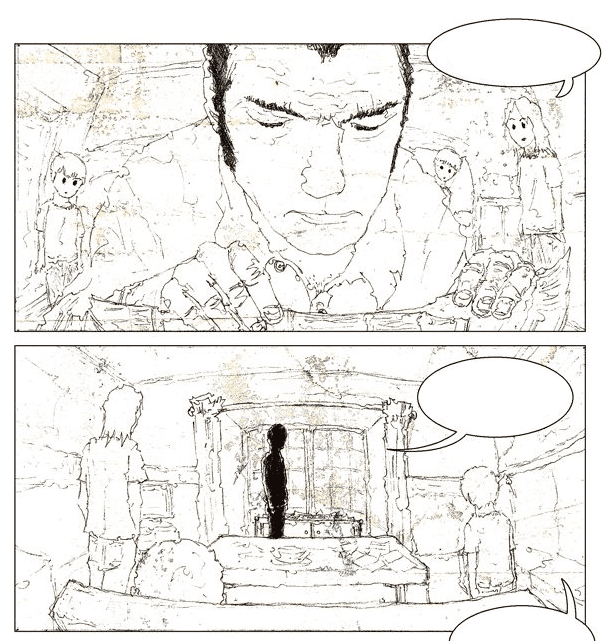It’s easy to say that everything will be ok until it’s your family that’s affected. Collateral – Dear John #2 continues to drive home how seemingly small problems can be bigger than the world around you. If you’re scrambling around looking for a job, no amount of villainy is more important than putting food on the table.
Victims of Circumstances still has the same problems that plagues it from its first issue. Even then, its story delves deeper into John and Mary’s family.
Victims of Circumstances: Understanding Collateral #2

Collateral – Dear John #2 is a webcomic self-published by Matthew Nicholls and Lee Taylor. Much like the first chapter, Matt is the writer whilst Lee is the artist for this chapter.
The story of Victims of Circumstances harkens back to the first chapter, Vacant City. Timmy, the youngest son in the family, talks about his friend, Stuart, whom they discover was taken by government agents who round up supers.
Whilst Timmy seems to be more accepting of meta-humans, Scott outright calls them freaks. As Mary tries to control the situation, she also drops that John is out looking for another job.
James, the oldest of the siblings, is pressured to find a job instead of going out for gigs. Around the same time, James gets a call, learning that his band will have a gig near supervillain territory, putting them in danger.
By dinner time, John shows up irritated, needing to find another job. His cold attitude continues until before they sleep, and the situation makes him feel more helpless.
Seeing The Family: The Story of Collateral – Dear John #2

Victims of Circumstances is a characterisation chapter for the main cast of Collateral – Dear John #2. From here, we see how the characters differ each other. We see how they act, how they handle pressure, and how they interact with one another.
From the start, Mary offers stability to her family. Her ability to balance everyone’s ego and manners whilst fulfilling her motherly duties shows her stellar strength of character. The dilemma, however, comes from everyone around her.
Timmy is a naive young boy who worships heroes and people with superpowers. Scott, the middle child, is at a stage where he shows signs of rebellious bigotry towards supes. The immature name-calling suggests he doesn’t fully comprehend the type of thinking he has.
James, the oldest son, is apathetic, looking more for himself than his family or others. John is the standard victim who is currently at his anger stage. He is irritable, annoyed, and indignant with how much the supers took away from him.
Whilst the plot of Collateral did not move much with this chapter, it doesn’t matter. The careful characterisation gives all types of readers a different path to follow. It sets up the family for several approaches that can change, twist, or continue with how their dangerous world moves about.
So far, Mary acts as the audience analogue in the story. She stays as the most reasonable out of everyone and acts as a true neutral anchor. Mary is strong enough to keep with what she believes in but vulnerable enough to worry about imminent problems.
It’s interesting to see where the four men’s archetypes will take them. John seems to be on the path to going full anti-super, whilst James is putting himself in unneeded danger.
Perspectives: The Art of Victims of Circumstances
There’s not much change when it comes to the art of Collateral #2. So far, the story’s focus on the main characters makes the art more palatable. The dirty, washout look of the art style lends to the further hopelessness that the family is experiencing.
If anything, the style improved at some areas, if only incremental. The portrait view of the characters showed their apathy, sadness, and even worry. Many panels in the pre-dinner and dinner scene look weirdly good.
The perspectives are emotive and the characters, even with their flawed art, look interesting. John, in particular, looked like the mess we expect him to be. Everyone looked consistent, and the focus on the eyes helps with the experience.
It’s hard to fault Lee for not adding a ton of details around areas he deems it unnecessary. The idea of the art he does is to tell a narrative rather than wow people with the fabulous art.
Lee is fantastic with perspective views, which works for his needs. It saves the amount of detail he needs to add whilst making the story feel more alive.
Should You Read Collateral – Dear John #2?
Should you read Collateral – Dear John #2, Victims of Circumstances? If you enjoyed the first chapter, you’ll likely enjoy this chapter further. Matt and Lee are asking the audience, through the main characters, who they are and who they support.
The story also opens several paths where the story can go, rather than follow everyone down a single journey. You can pick who to root for and you’ll see how they are struggling in this world full of hardships. In a world where supers are destroying buildings left and right, the narrative of everyday problems stands out. Knowing that heroes and villains are the same, the biggest concern is having to eat the next day.
